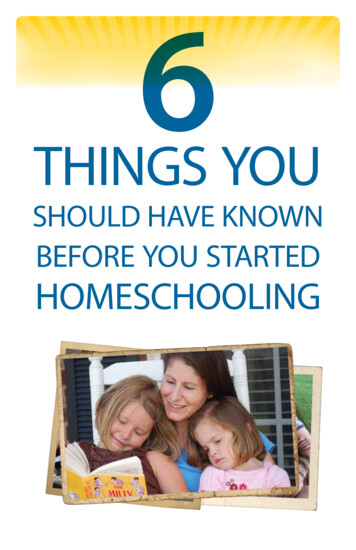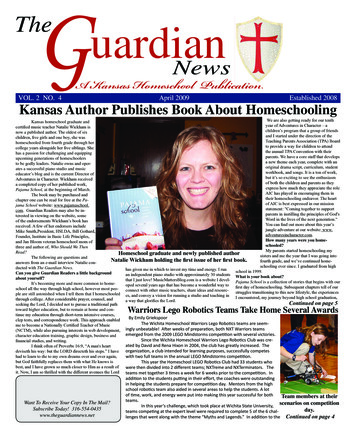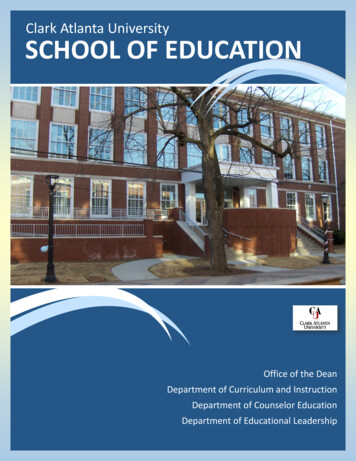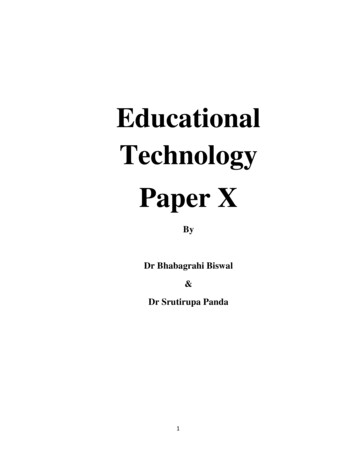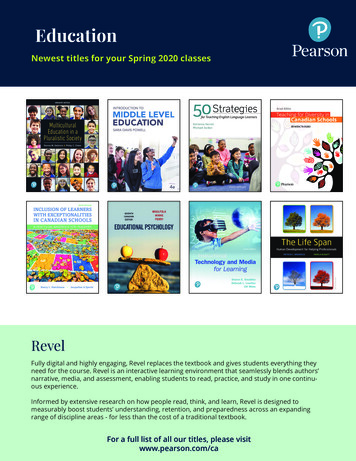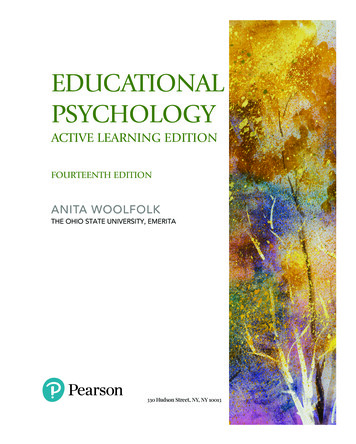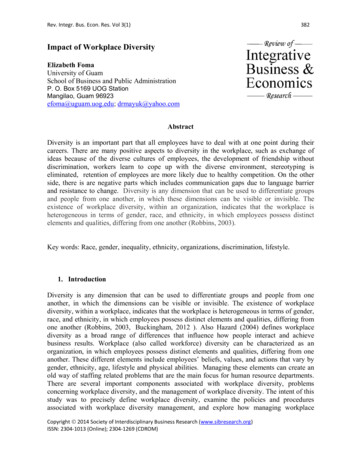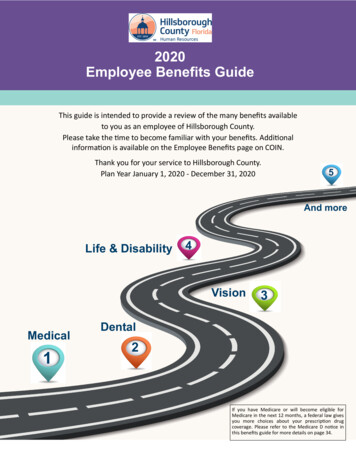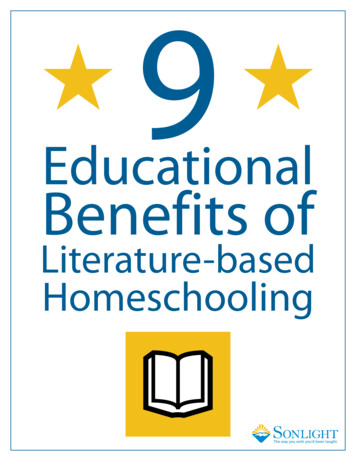
Transcription
9EducationalBenefits ofLiterature-basedHomeschooling
Audrey wondered if she should give up. She wanted her family to enjoyhomeschooling. But the daily textbook lessons felt so dull! Had she made amistake trying to teach her children at home?Audrey decided to change up her curriculum. In her own words, she gave a big“Goodbye to boring textbooks!!” and switched to literature-based learning.Her family now uses curriculum that centers on “real” books. They learn historythrough biographies and historical fiction, her kids learn to read through engagingstories instead of dry workbooks, and together they learn about cultures and theworld through gripping books. Audrey says:Our children (and I!) truly look forward to our school days now. I am so thankfulfor this opportunity to create such strong bonds with my precious children whilethey learn. –Audrey Z, Aug. 2011In other words, Audrey and her family love their homeschool now. But a bigquestion remains: are her kids really learning with this new approach? Is curriculumbuilt on literature-based learning just a fun option, or is it truly more effective thantextbooks or computer-based learning?Of course, every homeschool family is different; you have the wonderful freedomto choose the homeschool style that fits you. But strong evidence—and theexperience of thousands of homeschool families—shows that literature-basedlearning really does work.Consider nine educational benefits of literature-based learning.1. Literature conveys information inan enjoyable format.As a parent, you know that a bit of fun can make all the difference. As that cheerfulnanny says, “a spoonful of sugar helps the medicine go down.”That’s what literature does. It takes valuable information and knowledge — thatmay be rather bland on its own — and wraps it up in an “easy-to-swallow” story.Think back to your childhood for a moment. Do youremember the books your parents read to you? Green Eggsand Ham, Good Night Moon, Mike Mulligan and His SteamShovel . ?Do you remember the books you read by yourself, after you“graduated” from read-aloud time? Nonfiction books about
dinosaurs, airplanes, and horses . Fiction books like Frog and Toad, Make Way forDucklings, Homer Price, Old Yeller . Can you picture them . remember the stories .recall the characters?Most of us remember our favorite childhood books in vivid detail. In fact, we oftenwant our kids to read the same books we read as children.In those books you read as a child, you gained valuable insights, practicalinformation, exposure to various cultures, and a desire to acquire — or avoid —certain character qualities. Perhaps you learned about perseverance in The LittleEngine that Could, the value of family in the Little House on the Prairie books, orthe importance of loyalty in The Boxcar Children. You may have learned aboutPolynesian culture in Island of the Blue Dolphins, grappled with racism through Rollof Thunder, Hear My Cry, or “visited” Japan in Sadako and the Thousand Paper Cranes.You had a world of knowledge and experience right at your fingertips. You wantedto enter that world . and you enjoyed it when you visited.This is the experience you can offer your kids today. Through literature, you canintroduce children to people and places around the world and throughout history.You can give them worthy heroes who can inspire courage, integrity and generosityin your children. And you can do this in a way kids enjoy.You may wonder how the enjoyable nature of stories helps kids learn. Well, weknow that when kids read, they learn. And when kids enjoy learning, they want tokeep on learning. Literature-based curriculum capitalizes on that fact.Which type of student do you think will learn more? The one who protests againsteach assignment and book? Or the one who is sneaking off his “school” books to reread at night because they’re just so good?2. Literature conveys information in aformat that is easy to remember.Facts and figures without context are difficult to remember.That’s why a lot of memory systems rely on mnemonics andother memory tricks to memorize raw data.But put those same facts and figures into a story — give themcontext — and all of a sudden, it’s easy to remember theinformation! Stories serve as anchors for facts and figures thatwould otherwise be lost in the great sea of information in your mind.
Let’s compare an excerpt from a common seventh grade American historytextbook and a passage from a book that third-graders can read in literature-basedcurriculum. First, the textbook:The shot heard ‘round the world. On the morning of April 19, 1775,the first shots of the War for Independence (sometimes called theRevolutionary War) were fired at Lexington, Massachusetts. It is notknown for sure who fired the first shot, but it was a shot heard ‘roundthe world, for it was to change the course of human history.After killing eight Americans and wounding ten others at Lexington,the British marched on to Concord, destroying the military suppliesstored there. The Battle of Lexington and Concord was not quiteover, however. As the British troops headed back to Boston, patriotsfired on them from behind trees, shrubs, and barns. Although 93Americans died that day, the British lost 273 men. For a brief momentin history, little Massachusetts stood alone against one of the greatempires of the world.The Second Continental Congress. Less than a month after the Battleof Lexington and Concord, on May 10, 1775, the Second ContinentalCongress convened in Philadelphia. John Hancock was electedpresident. The assembled representatives of the American peopledecided emphatically that they would fight. The Continental Armywas established, a call was issued to the colonies to raise troops andfunds, and George Washington (1732-1799), who had distinguishedhimself as a lieutenant colonel in the French and Indian War, wasappointed commander-in-chief.1Did your eyes start to glaze over? It’s just information, laid out on the page, waitingfor little minds to somehow absorb it.But consider this segment from Johnny Tremain, a historical fiction work forelementary-age children. As a literature-based homeschool curriculum company,Sonlight Curriculum uses this book in our “Intro to American History, Year 1 of 2”program suitable for 3rd, 4th or 5th grade students. This excerpt describes Bostoncitizens watching British soldiers return from their defeat at the Battle of Lexington:Although no townsmen, except only the doctors, were permitted onthe wharf, Johnny knew that hundreds of them stood well back and1 Jerry H. Combee, Ph.D., Kurt Grussendorf, Beka Horton, Brian Ashbaugh, Susan Etheridge, History of the World in Christian Perspective,Third Edition (Pensacola, FL: A Beka Book, 1995), 310.
in the darkness, gloating. They were not saying much, only watching.Then one man began to whistle and the next took it up and the nextand the next. The whistling was shrill as a fife. They had not forgottenthe prophecy of that morning, ‘They go out by “Yankee Doodle,” butthey’ll dance to it before nightfall!’‘Yankee Doodle’ filled the darkness.Four more boats were coming in. Johnny dared move out onto thewharf, but he still kept well in shadow. More wounded. Could these bethe very men who had started out so confidently? Bedraggled, dirty,torn uniforms, torn flesh, lost equipment. Faces ghastly with fatigueand pain. Some were twisting and crying out.The first boats were filled with privates. They had been packed in, andnow were being tossed ashore, like so much cordwood. Most of themwere pathetically good and patient, but he saw an officer strike a manwho was screaming.Johnny’s hands clenched. ‘It is just as James Otis said,’ he thought. ‘Weare fighting, partly, for just that. Because a man is a private is no reasonhe should be treated like cordwood.’2The literature-rich approach to home education provides the context; itcommunicates information in the midst of a story. You can’t miss the drama because“you are there.” You feel the pain. You grieve the losses. You are there in the thick ofthings. And you understand and remember. You remember the years, or the generalplaces and times in history. Because you understand the broader context.Instead of a few paragraphs in a textbook, you get entire novels and biographiesthat you can’t put down. When your children have watched and experienced theRevolutionary War through Johnny Tremain’s eyes, they’ll remember why the warhappened, who was involved, what the costs were, what the conflict was, and whatthe results were. Pretty impressive stuff.My children remember the historical events far better with [a literature-basedcurriculum] than if they had read about them in a textbook. My children don’tunderstand how anyone can say history is boring. –Steph W, Aug. 20112 Esther Forbes, Johnny Tremain (New York: Dell Publishing 1943), 240-241. Sonlight item #DA04.
3. Literature encourages you tointeract with your kids.Many parents struggle to get their kids to talk to them. Maybe you’ve experiencedthis yourself. But when you use literature as the foundation of your homeschoolcurriculum, you may find it’s much easier to spark conversations. Goodconversations. Significant conversations.With a literature-rich homeschool program, you’ll spend some time each dayreading aloud to your children. This reading will often prompt a question or twofrom your children. They’ll ask about the story, the characters, or unfamiliar words.As you interact with their questions, you’ll sometimes findyou and your children enjoying entire conversations — thekind of conversations that will shape their thoughts andvalues.When your children read on their own, you’ll find it quitecommon for them to initiate conversation with youwithout being prompted . because it’s enjoyable forchildren to talk about the stories they’re reading.But even if your children don’t initiate a conversation with you, good literature-richcurriculum will provide direction and plenty of great discussion questions to helpyou along. One homeschool mom who uses Sonlight Curriculum wrote:Sonlight gives us a platform in which to explore and discuss the worldin light of our beliefs. My kids are learning how to think critically andlogically by reading all kinds of books and discussing all kinds of issueswith us. Sonlight has become more than a curriculum. It is part of ourlifestyle. —Elaine B of MassachusettsInteraction with your children helps you form meaningful relationships with them.Your discussions together are also vital to your children’s education. Simply talkingabout their learning helps your kids remember what they’re learning. And as youdiscuss with your kids, you can naturally assess how much your kids understandand where they need extra explanation. We believe that literature, more than anyother educational medium, encourages this interaction.
4. Literature helps your childrendevelop a superb vocabularyDo you know the single best way for children to acquire theenormous vocabulary they need to become educated adults?You guessed it. Reading!Even simple children’s books contain a much wider vocabularythan that which college educated adults use in day-to-dayspeech. Look at this excerpt from a classic children’s story forpreschoolers:Little Bear stopped now and then to eat berries. Then he had to hustle alongto catch up!Because his feet were tired of hustling, he picked out a large clump ofbushes and sat down right in the middle and ate blueberries.3Just think of those words (in a book for preschoolers) – when is the last time youused the words “hustle” or “clump” in everyday speech? Or what about the phrase“now and then”? This is all vocabulary your children should certainly learn. Whenthey read regularly, they will naturally absorb scores of new words without evenrealizing it.You can buy special “vocabulary curriculum” such as flash cards and workbooks.Those can be a helpful supplement. But by themselves, they can’t even come closeto building the kind of vocabulary that reading will. As children learn new words incontext and see them again and again in various books, they will absorb the newwords as part of their toolbox of words.We believe that reading is really the best (perhaps the only) way children candevelop the extensive vocabulary they’ll need for academic and professionalsuccess in life.3Robert McCloskey, “Blueberries for Sal.” Make Way for McCloskey. (New York: Viking 2004), 33-34. Sonlight item #TA04.
5. Literature helps your childrendevelop global awarenessDo you have money in your homeschool budget for a trip around the world?Probably not.But as global commerce and politics becomes increasinglyinterconnected, we must prepare our children for the worldwe live in. As adults, our kids will probably interact and workwith people from a huge variety of cultures. At the very least,they will see and hear about these cultures on the news.So how do we prepare them for this? Aside from traveling,reading may be the best way to help children become awareof the world. Reading opens doors for children to walk in theshoes of people very different from your own family. Literature lets you see theperspective of characters who have lived throughout history and around the world.Fiction and biographies answer questions such as: How do children on the otherside of the world live? What do they wear and eat? How do they play? How do theyinteract with their families? How do their families worship? What do they believe?How do they view the world?As your children learn these points about different cultures, they also learn another,more important point: people are people. As you read “real books” with your kids,they learn to appreciate the uniqueness of different races and nationalities.Good literature-rich curriculum should include books that help you get to knowcultures very different from your own. You can meet characters (fictional and real)from Peru and Pakistan, China and Cambodia, South Africa and Switzerland. As youjourney with these characters in gripping books, your kids will come to see peopleof that culture as real people, just like yourself.You may be impressed with how similar people really are around the world. Maybetheir houses are a little different, but they still have houses. Maybe their food isdifferent, but they still eat food. Maybe their practical day-to-day struggles lookdifferent than ours, but these characters still have emotions like ours, families likeours and hopes and dreams like ours. If you help your children understand this,what a gift you have given them!
6. Reading develops cultural literacyVocabulary and global awareness may be part of a broader category: culturalliteracy. As E. D. Hirsch, Jr. demonstrates in his bestselling work, Cultural Literacy,there is a certain basic set of background information people must know if they areto get along in a culture—let alone to influence it.They must be aware of the key historical events, significantpersons, movements, groups and ideas that have shapedthe culture. If you want your kids to influence the world, toimpact the world for good, you must place a premium oncultural literacy.But how do you help kids gain the variety of backgroundknowledge they need?Literature-based curriculum does wonders to help with that. After laying out thecase for why we must be concerned with cultural literacy, Hirsch discusses how wemight create school materials that advance cultural literacy. He writes:The single most effective step would be to shift the reading materials usedin kindergarten through eighth grade to a much stronger base in factualinformation and traditional lore. What is needed are reading texts thatdeliberately convey what children need to know and include a substantiallyhigher proportion of factual narratives.4Literature-based curriculum does this by deliberately choosing books thatteach your children history, cultural allusions (such as ancient Greek heroes likeHercules), and the way ordinary people have lived throughout history. Literaturebased curriculum biographies and other “factual narratives” that convey specificinformation. And as we’ve seen above, the fact that this information is presented inan engaging and enjoyable format helps kids absorb the facts they read.As students follow a literature-based curriculum, they will naturally become awareof important historical, cultural and societal events, as well as crucial aspects ofliterature that one must know (such as the concept of “Big brother is watchingyou” from George Orwell’s novel 1984). Students must be aware of these booksand their content so that they have a foundational base of knowledge and, moreimportantly, so they will be prepared to respond to these cultural influences in astrong and godly fashion.4E. D. Hirsch, Jr., Cultural Literacy. (New York: Random House, Inc. 1988), 140. Sonlight item #RR106.
7. Literature can help your childrendevelop emotional intelligence andempathy.Reading takes us out of our own thoughts for a while. Weenter into another’s world and experience life through theireyes. We consider their predicaments and hope for goodoutcomes.In this way, reading—particularly fiction—helps childrenbecome more empathetic.Empathy, in turn, helps our children develop a heart of compassion for a brokenworld. It helps them look beyond the “stuff” of life the rest of the world runs afterand focus on what is truly important. Empathy helps us and our children seebeyond our own feelings and be aware of those around us. It helps our childrenrecognize and identify with the emotions of others. For example, it may not be untilyour children read Roll of Thunder, Hear My Cry that they realize what others mightfeel like when they face discrimination for the color of their skin. Or maybe theclassic story The Hundred Dresses will help your children grasp how hurtful it is tomake fun of others.Over the last few years, several studies in Psychology have pointed out how readingfiction helps develop empathy. As Dr. Keith Oatley of the University of Torontowrites,Through a series of studies, we have discovered that fiction at its bestisn’t just enjoyable. It measurably enhances our abilities to empathizewith other people and connect with something larger than ourselves.5In real life, we may get occasional glimpses into other people’s minds. A friendmay tell us exactly what she’s thinking or how she feels, and we can respondaccordingly. Usually, however, we just have to guess at people’s thoughts, emotionsand motives.Children aren’t born with this ability to guess at people’s inner worlds; it’ssomething they must learn. And first, young children must learn that other peopleeven have emotions and desires distinct from their own.5“Changing Our Minds,” Winter 2009. Accessed March 2012 at ng our minds/
Fiction helps teach this because it gives a free pass into other people’s minds. We mightsee how a character feels when someone makes fun of her (as in The Hundred Dresses),how she reacts to a scary situation, and how she shows her family that she loves them.What a valuable resource! Oatley writes:We set aside our own plans and concerns for a while as we take up ourbook; we then take on the plans and concerns of a fictional character, andempathetically imagine what that character might feel.6Fiction helps us imagine what others are thinking and feeling and trains us to feelempathy for others.How does it do that? Since “novels can be thought of as simulations of how people reactto combinations of social forces,” reading them helps us “construct a mental model ofthe person to know what’s going on inside their heads.”7 In other words, reading helpschildren guess and understand what others are feeling; it helps them grow in emotionalintelligence. This ability seems to transfer over into real life.You can read more about Oatley’s studies here. But whether or not you know the sciencebehind it, know that with a literature-based curriculum, your times reading together servemultiple purposes at once. You’re not just learning history, geography and culture. You’realso giving your children lessons in empathy and emotional intelligence. That seems liketime well spent!8. Reading with your children can helpthem develop good characterMost homeschool parents not only want their children to receive a great academiceducation, they also want their children to become good people. They want to raise theirchildren to be people of integrity and character. After all, whatgood is knowledge without character?So then, how should we help our children develop righteousand godly character?We believe that “character is caught, not taught.” People developgood character by observing the behavior of others whom they6The Psychology of Fiction,” September 2011. Accessed March 2012 at -fiction/201109/narrativeempathy7 “Changing Our Minds,” Winter 2009. Accessed March 2012 at ng our minds/
respect and by letting the truths of the Bible sink into their life. Good charactercomes not during structured morality lessons, but through addressing issues asthey arise in real life and discussing tricky questions with people you trust.Children can also form character by meditating on and talking about the lives,moral dilemmas and ethical (or unethical) behavior of believable characters inrealistic stories.In order to provide plenty of fodder for this kind of meditation and discussion,good literature-rich curriculum includes books whose protagonists confrontrealistic ethical and moral dilemmas, work through them and overcome in the endto make righteous decisions.We are convinced that the presence of true conflict and struggle in qualityliterature makes their moral or character-oriented “lessons” not only believable, butapplicable as well.In contrast, one homeschool mom, Jill, tells about trying to teach morality throughsimplistic moral tales such as “Never Tease a Weasel.” Her children listened to thetales, but saw through the thin veneer and didn’t apply the morals to their lives.Sure, they learned why you shouldn’t tease a weasel, and that ducklings must obeyat the first call from their mother. But the tales were contrived and abstract. Theydidn’t translate into real life and help Jill’s children understand that they shouldn’ttease each other, or that they should listen when Mom called. You can read more ofJill’s frustration here.If moral tales don’t really work, why do “real books” do the trick? Because kids payattention to believable characters in believable situations. When kids read aboutsomeone who honestly struggled and came out on top, they perk up.Kids often view courageous characters as heroes. And we believe that helpingchildren find true heroes to emulate will help them develop their character morefully than will simply memorizing facts about character traits. Moreover, we believethat when children read of real people (or believable fiction characters) who facesignificant challenges, remain faithful to God and overcome their circumstances,they will develop heroes worth imitating. Children will be inspired to live withcourage and faithfulness, just like their heroes, and character will grow out of thisinspiration.Plus, literature gives you many opportunities to discuss character and moralitywith your children. If you’re reading the quality books included in a literature-rich
curriculum, your children will learn to enjoy them and be eager to talk about them.You’ll be able to discuss characters they admire (like brave and compassionatemissionaries, or children who overcome great obstacles). As you read thesecompelling stories together, you can ask questions such as: What would you have done in this situation?What kind of consequences do you think could come with this character’sactions?How do you think this character showed bravery (or kindness, or honesty, etc.)?When children see good character in books and honestly discuss it with theirparents, they gain inspiration and practical know-how to grow in virtue.(And in case you’re wondering, Jill didn’t stick with the moral tales for long. Shediscovered the power of reading real books as fodder for discussions on character.Click to read about five of Jill’s favorite “real books” that teach character.)9. Literature helps students becomegreat writersThe best writers read a lot. Any good writing course will teach you this. Beforeyour children become the next Mark Twain, they must first learn to imitate the style,flow and cadence of established writers.Even if your children don’t hope to write stunning novels, theywill still need to learn to write clearly and winsomely. Readingis the best way to help your mind absorb the grammar, syntax,vocabulary and rhythm of good writing.Your children can’t stick to comic books and dry textbooks ifthey are to learn how to communicate well. Consider what onehome educator wrote:I have a BA in English, emphasis on Literature. I teach writing/composition to ourlocal homeschool co-op. Do you know what I have found? Without exception,the best writers have been kids who read quality books! The kids who usetextbooks just don’t get it. –Sarah M. in MI, June 2010Perhaps your children can learn to write without reading widely. But why give themthat extra burden? You can train their ear to recognize and imitate good writingfrom their earliest days of cuddling on the couch reading aloud together.
When your homeschool centers on great books, your daily times reading togetherwill reap yet another “double-duty” benefit—you’ll help pave the way for your kidsto learn to write well.***So there you have it. Literature-based learning isn’t only fun. It’s also a very effectiveway to learn! In short, using a literature-based homeschool curriculum:1. Gently encourages your children to love learning, even as it 2. Helps them remember what they learn, and3. Helps you learn alongside your children and engage them in meaningfuldiscussion.Plus, literature-based homeschool curriculum capitalizes on the huge benefits ofreading quality books. At the very same time as they teach history/geography andculture, your “real books” also4. Help your children naturally build vocabulary,5. Develop global awareness and6. Increase cultural literacy.7. Help your children develop emotional intelligence as they learn how to seewhat other people are feeling (which in turn helps them become empatheticpeople).8. Give your children worthy, virtuous heroes to emulate and provide primeopportunities to discuss what good character looks like in the real world.9. Lay the foundation for your children to become great writers.Phew! With all that rolled into one relaxed homeschool experience, is it time youconsidered literature-based learning for your homeschool?***If you’d like to see what literature-based learning could mean for yourfamily, consider Sonlight Curriculum. For over 22 years, Sonlight hashelped parents give their children a remarkable book-rich education.With complete homeschool guides that walk you through each day,you’ll have everything you need to sit down with your children, read,grow and learn together. In fact, you and your children will love tolearn together with Sonlight. We guarantee it.See what it’s all about: discover Sonlight today!
2 Esther Forbes, Johnny Tremain (New York: Dell Publishing 1943), 240-241. Sonlight item #DA04. 3. Literature encourages you to interact with your kids. Many parents struggle to get their kids to talk to them. Maybe you’ve experienced this yourself. But whe

